 This interview is an excerpt from The WildLife with Laurel Neme, a program that explores the mysteries of the animal world through interviews with scientists and other wildlife investigators. “The WildLife” airs every Monday from 1-2 pm EST on WOMM-LP, 105.9 FM in Burlington, Vermont. You can livestream it at theradiator.org or download the podcast from iTunes, laurelneme.com or laurelneme.podbean.com. This interview is an excerpt from The WildLife with Laurel Neme, a program that explores the mysteries of the animal world through interviews with scientists and other wildlife investigators. “The WildLife” airs every Monday from 1-2 pm EST on WOMM-LP, 105.9 FM in Burlington, Vermont. You can livestream it at theradiator.org or download the podcast from iTunes, laurelneme.com or laurelneme.podbean.com.Dr. Laurel A. Neme is also the author of ANIMAL INVESTIGATORS: How the World’s First Wildlife Forensics Lab is Solving Crimes and Saving Endangered Species. |
This interview originally aired on March 14, 2011. It was transcribed by Kirstin Fagan.
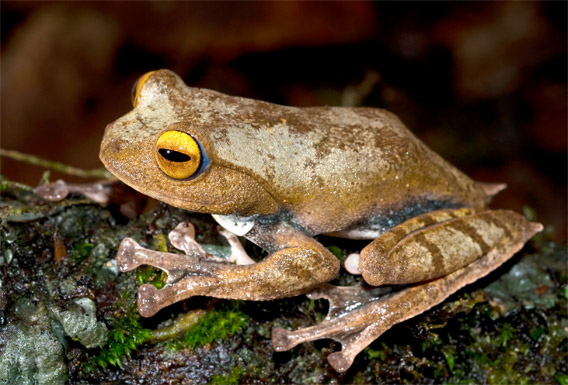
Rhacophorus vampyrus frog, which Bryan Stuart helped discover and describe. Photo by Jodi J. L. Rowley
Bryan Stuart’s mission as a curator of amphibians and reptiles at the North Carolina Museum of Natural Sciences is to understand the diversity of life on earth. For that, he documents what species occur where and why. He’s particularly attracted to areas where there’s a dearth of knowledge, like Laos, Cambodia, Vietnam and Gabon, and so far has discovered 27 species unknown previously to scientists: three species of snakes, two types of salamanders, and 22 kinds of frogs.
Scientists don’t always have to go far to find new species. In 2010, a new species of pygmy salamander from North Carolina was discovered that had previously been thought to be part of a single species. Using DNA technology and closer examination of its external appearance, scientists at the museum found that populations on either side of the French Broad River were actually two separate species. Similarly, Stuart’s colleagues have uncovered examples of species of amphibians and reptiles previously unknown in North Carolina, including a map turtle making its home in the western mountains of the state.
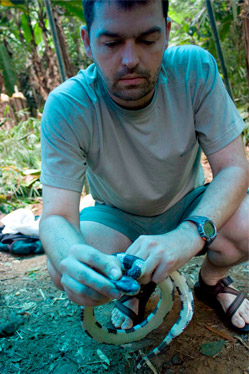 Herpetologist Bryan Stuart. Photo by by Chris D. Hallam. |
In many cases, distinct new species are being discovered because scientists are now working in previously unsampled areas. In other cases, they’re using new technologies, such as DNA analysis, to re-examine species they thought they knew. In the following interview, Stuart reveals what it means to discover a new species, and takes us step-by-step through the process.
Bryan Stuart received his Bachelor of Science in biology from Cornell University, a Master of Science in zoology from North Carolina State University, and a Ph.D. in biology from the University of Illinois. He also held a postdoctoral appointment at the Museum of Vertebrate Zoology at the University of California, Berkeley, before returning to Raleigh to join the North Carolina Museum of Natural Sciences in September 2008. Much of his research has focused on amphibians and reptiles of the Old World tropics, especially Southeast Asia, where he has maintained an active field program for the past decade. He has particular interest in using molecular tools to define species boundaries and unravel their evolutionary histories.
This interview is an excerpt from The WildLife with Laurel Neme, a program that probes the mysteries of the animal world through interviews with scientists and other wildlife investigators. The WildLife airs every Monday from 1-2 pm Eastern Standard Time on WOMM-LP, 105.9 FM in Burlington, Vermont. You can livestream it at www.theradiator.org or download the podcast from iTunes, www.laurelneme.com, or http://laurelneme.podbean.com.
THE EARLY YEARS OF A HERPETOLOGIST
Laurel Neme: How did you get interested in reptiles and amphibians?
Bryan Stuart: I don’t have necessarily a defining moment. I was really born a herpetologist. My whole life, from my very earliest memories, I was fascinated with animals, and I had a particular interest in amphibians, reptiles, and birds. Of course, birds are just feathered reptiles.
Laurel Neme: How did your interest manifest itself when you were young? Were you always catching frogs or bringing snakes home to mom?
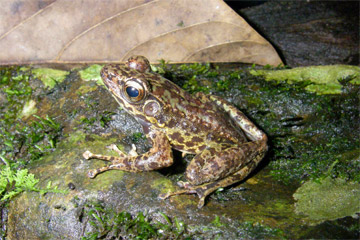 Odorrana bolavensis, a species first described by Bryan Stuart. Photo by Stuart. |
Bryan Stuart: My early years were spent in suburban Chicago, so we didn’t have a very high diversity of these animals around. I do have a memory of visiting an aunt in rural Michigan when I was about five years old and we caught a garter snake on a walk through the woods. That was the first snake I had ever seen in the wild, and that left quite an impression on me. But really, I learned everything from reading. I was an avid subscriber to Ranger Rick Magazine, and I amassed every book that I could get my hands on. While other little kids my age were out playing sports and video games, I was obsessively reading about these things or, of course, watching television shows about animals. That’s where it all came from—and, as a result, I am today a terrible athlete. I’m still learning the rules to football. So, there are consequences for making these choices early in life.
Laurel Neme: (Laughing) But you can probably identify every reptile and amphibian in the area…
Bryan Stuart: I do have a good familiarity, although I certainly can’t identify every species in the world. There are so many. But there are many groups that I am very familiar with, yes.
THE LIFE OF A CURATOR
Laurel Neme: You are now curator of herpetology for the North Carolina Museum of Natural Sciences. What do you do as curator?
Bryan Stuart: Essentially, curators are responsible for documenting and understanding the diversity of life on earth. As a curator of herpetology, I’m responsible for documenting and understanding the diversity of amphibians and reptiles. By that I mean, what species occur where, and why. That is really the core of my research program. As museum scientists, we are responsible for maintaining collections of preserved specimens of amphibians and reptiles. Many of these are very, very old historical collections of amphibians and reptiles, records that come from places where populations no longer occur. Many of the collections go back into the nineteenth century, for example. We’re also responsible for curating the data that are associated with these collections, including photographs, field notes taken by people who made the collections, and so forth. Then, the other component of my job as curator is to conduct research using those collections.
Laurel Neme: What kind of research?
Bryan Stuart: This can range from producing guides or popular articles on the natural history or distribution or biology of the species, to producing scientific publications that try to determine the evolutionary relationships of these animals, what it is that they’re doing in the wild, for example, studying their stomach contents, and especially looking at species diversity; what is a species, and how do we recognize it.
Laurel Neme: Are you mostly physically in the museum working with the collections, or are you out in the field?
Bryan Stuart: Both. We do spend a lot of our time here in the collections, and I have a team that works with me to maintain the collections. We spend a lot of our time trying to make these collections as useful as we can to other user groups, and by that I mean other members of the scientific community or resource managers. We make the collections available to visitors who have a legitimate purpose for studying the collections, and we make these collections available on loans to other researchers, all over the world, in fact. We also strive to get the data from our collections into an online web portal, so that the data are available to the public, and so people can use these specimen collections to understand species’ distributions and so forth.
Laurel Neme: When you say you’re getting the data online, what kinds of web portals are you using?
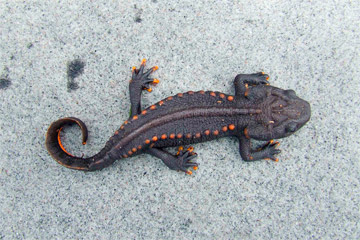 Tylototriton notialis, which was discovered and first described by Stuart. Photo by Bryan Stuart. |
Bryan Stuart: Basically, for each record that is in our collection we are trying to have a record in a database that’s accessible to the public, where people can see what species that record is, and where it was obtained, when, by whom, and any of the associated data that go with it—for example, the weather in the area, the habitat, both the macrohabitat, generally for example the forest type or the landscape in general, or microhabitat, the very details of where that organism occurred when it was found. As a result, because these collections date back so far, they provide an opportunity to map the past distribution of these species. We document the occurrence of these species in areas where they’re no longer found. The records document current distributions of species, and in some cases people use these records and incorporate them into models using GIS technology, to predict distributions of species. So, in other words, they look at known localities of the species, and based on environmental parameters where the species occur, they can use GIS technology to predict where else on the landscape we might expect that species to be found.
REVELATIONS FROM A MUSEUM COLLECTION
Laurel Neme: Can you give me an example of a species that is no longer found in the area where you have a specimen?
Bryan Stuart: For example, a very interesting species of snake that occurs here in North Carolina is the coral snake. The coral snake belongs to [the same] family of snakes […as] the cobras. It’s a venomous species of snake. They’re actually a very secretive species, and there are very few records of people being bitten by them because they’re such a secretive and non-aggressive species.
Laurel Neme: What do coral snakes look like?
Bryan Stuart: They are beautiful animals. They have a red, black, and yellow ringed pattern. They’re not very big. A large adult might get to the diameter, say, a little bit larger than maybe the pinky finger of a man. The northern end of their range is within North Carolina. They tend to occur in areas that have sandy soils. In North Carolina, there’s a geographic area in the south central portion of the state called “the Sand Hills,” which is essentially a very endangered long-leaf pine ecosystem.
Laurel Neme: What do you know about coral snakes from the museum collection?
Bryan Stuart: What we know from our collections here at the museum is that, historically, coral snakes occurred in the Sand Hills region of North Carolina. But, for some reason, they are no longer found there today. Our collections document that the species occurred in the Sand Hills region up until about the 1960s, and there have been no verified records since. However, the species still occurs in a few other scattered localities primarily in the extreme southeastern portion of the state near the coast. [Because of] our collections, [we know that] up until just 50 years ago, the species had a much larger geographic distribution in the state.
Laurel Neme: Is someone looking into why it no longer occurs there?
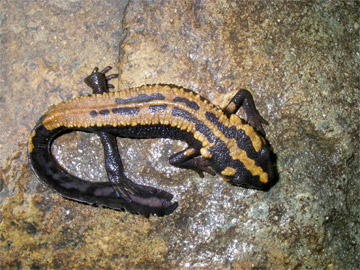 Laotriton laoensis, another species discovered by herpetologist Bryan Stuart. Photo by Stuart. |
Bryan Stuart: A number of herpetologists have wondered, and I suspect we will get some answers at some point in the future. One hypothesis that had been put forward is, because coral snakes are diurnal, meaning they are day active, and they’re ground dwelling, they crawl on the ground or just below the surface, they don’t climb in trees for example, they are a species that might be susceptible to the invasive fire ant. Fire ants were introduced in this part of the world, and they are known to attack and kill small terrestrial animals. A coral snake is an example of a species that might actually be susceptible to being killed by fire ants. So, that is one hypothesis that has been put forward for why coral snakes no longer occur in the Sand Hills, an area that is, indeed, plagued with fire ants. However, the real answer may be much more complicated. For example, it may something to do with climate change. I think it would very interesting for somebody to investigate that question more thoroughly, and our collections would provide a source of data for pursuing that question.
Laurel Neme: Are fire ants found in the other areas where coral snakes are found, such as the extreme southeast portion of the state near the coast?
Bryan Stuart: That is a good question. I think fire ants are pretty widely distributed throughout the state now. I’m not exactly sure why they may persist there and not elsewhere.
Laurel Neme: What else is in the museum’s herpetology collection? Is it primarily species from North Carolina, or from all over the world?
Bryan Stuart: Our collection consists of approximately 180,000 preserved specimens, and this dates back to the late 1800s. The strength of our collection is certainly North Carolina and adjacent portions of the southeastern United States. However, we have growing representation from other countries around the world. We now have approximately 20 other countries represented within our collections, including now some important collections from Southeast Asia and from Central Africa, two areas in the world where I conduct some of my field research. Most the collections that we have coming in from North Carolina now are usually animals that are salvaged. For example, we have many, many road-killed animals that come in and provide the source for additional records. We take DNA samples from these animals that come in and make them available to the scientific community.
CLOSING THE KNOWLEDGE GAP
Laurel Neme: What gaps exist in the collection or in our knowledge?
Bryan Stuart: It may be a surprise to some people to know that we actually have a lot to learn, not only about geographic distributions of amphibians and reptiles in North Carolina, but also even what species occur in the state.
For example, just in 2010, a new species of salamander was described from North Carolina. That was an example of a species that was previously thought to be a single species but then was actually found—on the basis of morphology, its external appearance, and using DNA technology—that populations on either side of the French Broad River were actually recognizable as two separate species. So that was a case of one species being split into two.
There is also another undescribed species of salamander from that Sand Hills region (that we talked about regarding coral snakes). My colleagues have been finding, very recently, examples of species of amphibians and reptiles that had never been previously known to occur in the state. For example, a species of map turtle was just documented about two years ago, to occur within North Carolina. It’s in the mountains of North Carolina, the extreme western part of the state, and there had been no native map turtle known to the state of North Carolina prior to this work done by my colleagues here at the museum.
Even though North Carolina is not a distant land of faraway, tropical, poorly explored landscape, we still have a lot to learn about the species that occur here. The records that we continue to accumulate are certainly very valuable to science, and to conservation resource managers.
NEW SPECIES DISCOVERIES
Laurel Neme: You personally have discovered how many species?
Bryan Stuart: So far, I have named twenty-seven species, all species that occur in Southeast Asia: three [kinds of] snakes, two salamanders, and the rest are frogs. And, in the few collections that I’ve made, there are additional undescribed species just waiting to be described and formally named.
Laurel Neme: How have you come to discover so many species?
Bryan Stuart: My interest as a biodiversity scientist, as a museum curator, is understanding what species occur where and why. As a result, I am attracted to working in areas where there is a dearth of knowledge; poorly explored countries where we have very little understanding of what species of amphibians and reptiles even occur in the country.
The two parts of the world where I now spend most of my field time is mainland Southeast Asia, formerly called French Indochina, which consists of the modern countries of Laos, Vietnam, and Cambodia, and I spend especially most of my time in Laos. I have also started recently working in Central Africa, in the country of Gabon. Both Laos and Gabon are countries that have historically been very poorly sampled for amphibians and reptiles. We still have a lot to learn there.
Laurel Neme: Do you work with other scientists in the country?
Bryan Stuart: [I have a number of] collaborators, who both in-country scientists, so scientists from those countries, in Laos, Cambodia, or Vietnam, and collaborators, people like myself, who occur for example here in the United States, or in Canada, or Europe, or Japan.
We have been studying the collections that we’ve been making in those very poorly studied areas, and in many cases we very often find new records from those countries, species that have never been known to occur in those countries previously, and we also find new species to science. What that means is that these are species that have never been described and formally named, and so are not recognized.
WHAT IS A “NEW” SPECIES?
Laurel Neme: What, exactly, do you mean when you refer to a “new species”?
Bryan Stuart: I always am very careful with the way I use the term “new species.” I like to say “new species to science” because of course there’s a little bit of a Western bias here when we use that term, in the sense that this frog that we collect in a rural part of the jungles of rural Laos may be unknown to science, in that it’s never been described or named by scientists, but in fact it is often very well known to the local people who live in that part of the world. And so we of course need to be very careful as to what we mean by “new species.”
Laurel Neme: So, there’s “new species to science”, which have never been described or formally named, and then there’s also “new to that country,” where it had been never known to occur in those countries. And in both cases, it may very well be known to the local people.
Bryan Stuart: Correct. I just want to be very careful when we’re talking about new species, whether it be new country records or new species to science, it is not the case that these animals have never been before seen by humans, because that’s often not the case. It is sometimes, especially when we’re looking at diminutive species, very, very small animals, often ones that live underground, and which have very little economic value; they aren’t eaten, they have no medicinal value, nothing like that. Those species are often overlooked, but that’s more the exception than the rule.
Laurel Neme: Have any of your discoveries been one of those diminutive species that weren’t known locally?
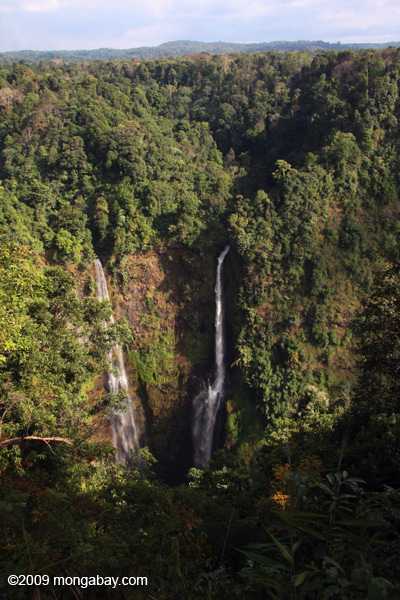 Waterfalls on the Bolaven Plateau in Lao PDR. Photo by Rhett A. Butler |
Bryan Stuart: That’s a little unclear. I’ve described a number of very small species, and it’s a little unclear because the local taxonomy, or the local naming system, doesn’t always have a one to one correspondence with scientific classification. Sometimes one local name is used to represent more than one scientific species. For example, a local name might be used for “waterfall frog,” but when in fact there is more than one species that we recognize as scientists that occur in the waterfall. Conversely, sometimes more than one local name is used that apply to a single scientific species. For example, sometimes, different names are applied to juveniles and adults of the same species. There’s not always a one to one correspondence in local taxonomy versus scientific taxonomy. It’s often a little unclear.
But I just want to be very careful because oftentimes people who discover species may inadvertently portray the notion that they’re the first humans to find this thing, when in fact that’s very unlikely to be the case.
Laurel Neme: Sort of like Columbus supposedly “discovering” America.
Bryan Stuart: Yeah. Certainly local people often have a lot to offer. I’ve worked with many very skilled hunters, people who escort us into our remote field camps, and provide us assistance as guides. They often have an incredible knowledge of the local species that occur in those areas.
When we look back through natural history, there are a number of examples of cases where information was provided to visiting scientists, and often the scientists ignored that information, and later the local people were vindicated. For example, there’s a famous story of the Sullivan Island parrot, where the males and female are very, very different in coloration. When they were first collected they were described as two separate species because the males and females are so different, and yet, apparently the story goes that the local people in the Solomon Islands knew very well that one was the male and one was the female of the same species.
STEP-BY-STEP: SPECIES DISCOVERY IN THE FIELD
Laurel Neme: Can you take me on one of your recent trips that involved a discovery?
Bryan Stuart: Sure. I’ll talk about my trip in July of 2010. I was working on an isolated mountain in the southern part of Laos, called the Bolaven Plateau.
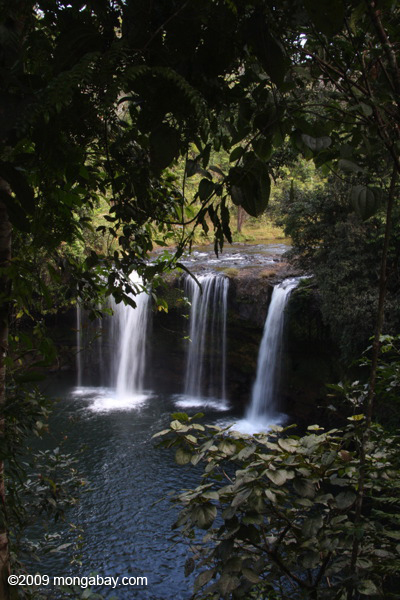 Waterfall on the Bolaven Plateau. Photo by Rhett A. Butler |
When I do my work, I am always very careful work with local scientists and students. Often in these countries there are very few people who have real expertise in the amphibians and reptiles of their country. So, in some cases, I’ve worked with people who just have a very general background, for example in forestry or wildlife management, and may know nothing specifically about amphibians and reptiles. But I have a network of collaborators in Laos. I now work through two organizations in Laos: the non-governmental organization, the Wildlife Conservation Society (WCS) and through their joint program with the National University of Laos in the Biology Department. What I do is I work with a Lao professor and Lao Masters students in that department. There’s a brand new Masters of Science program in Laos, and there are these young eager students in Laos who are looking to be trained in biodiversity science. So I’ve got this wonderful network of collaborators now.
With my Lao collaborators we go to these remote areas, and we bring government officials with us from the Forestry Department, and we essentially go to the last village on the road, the one that’s closest to the forested area where we want to work. We spend some time in the village showing our permission paperwork to be there, and also having long conversations with the villagers. We notify the headman of the village about what it is we want to do and why. People in Laos are wonderfully hospitable. Essentially what we do is put together a team. So now our team consists of myself, it consists of my colleague, a Lao professor, it consists of our joint Laos students who are looking to be trained in amphibian and reptile biodiversity, it consists of government counterparts from the Department of Forestry, and it consists of these local villagers in these rural villages.
Laurel Neme: At this point, how many people do you have doing the research?
Bryan Stuart: At this point, we number perhaps as many as ten or fifteen people and we head out into a spot in the forest that is remote. We try to get to intact, pristine forest that is undisturbed, and we set up a campsite, usually along a stream so we have a good source of water. We usually work for about a week in a camp. On one trip I usually have about three one-week camps.
Laurel Neme: How do you work from the camps?
Bryan Stuart: What we do then is we head out as a group into the forest, both during the day and especially at night, and we walk through the forest. We look under debris, we look under leaf litter and logs, we look up into the vegetation above us, we walk along streams, we look in the water and on the stream banks, and we look for amphibians and reptiles. We try to document as many different species as we can. We take photographs of these animals, we take DNA samples of these animals, and we usually preserve a few representatives of each as museum specimens, which then ultimately, those specimens and those DNA samples, come back with me to the museum here in the United States, and then we go through and look at them and check their identifications.
What’s very interesting is we look at the specimens, we look at the DNA, and in the case of frogs, we also listen to their calls. We make call recordings in the field as well of calling frogs, and we use this information to make our identifications, to try and ask the question, “Are these the same or different species?”
During the course of that work, we very often uncover species that are new to science. In many cases, these are frogs that really are novelties. They are things that are different in their external appearance to such a degree that they are immediately recognizable as something new to science; they don’t resemble any other known species.
Laurel Neme: Then what? What does it take to describe a species scientifically?
Bryan Stuart: To describe a species, really a large part of the work is going through the literature and looking at museum specimens, both at your own institution and at institutions around the world, and making a determination that in fact this species has never previously been formally named. Often, it is the case that we get these novelties, these things that are externally very different in appearance, but when we look at their DNA sequence data or we listen to their calls we realize that, in fact, these things are different as well.
In some cases, we discover populations of species that have a very different call or have a very different DNA sequence, and yet externally they don’t necessarily look different from other described species. One of the phenomena that we now realize in amphibians is that one species often changes into another during evolutionary time, but that change, that we call speciation, is not always accompanied by a change in their external appearance.
CRYPTIC SPECIES
Laurel Neme: Why not? Why isn’t speciation always accompanied by a change in external appearance?
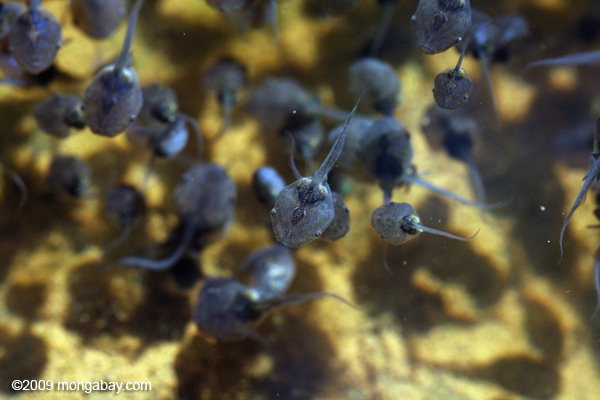 Tadpoles on the Bolaven Plateau. Photo by Rhett A. Butler |
Bryan Stuart: The reason for that is that salamanders and the other group of amphibians that are unfamiliar to many people, called the caecilians – which are the limbless or burrowing amphibians that look in many ways like a worm (but they’re actually an amphibian) – tend to use pheromones, or chemical signals, for mate recognition, whereas frogs use calls for mate recognition.
Very rarely do amphibians use their external appearance to recognize mates, to recognize the same species. So, you can imagine there are many, many examples where species diverge through evolutionary time, but they don’t necessarily change in their external appearance. These are what we call cryptic species.
Cryptic species have historically been overlooked because, in the past, museum scientists, going back for the last 200 years or more, only had the external morphology of these animals to look at from their museum specimens. But today we have additional tools: we have these call data and we have DNA sequence data. These new kinds of data are actually showing us that we have often overlooked species in the past.
In many cases, these very distinct new forms have never been found because we’re working in areas that have never previously been sampled. In other cases we’re going back and looking at species that we thought we knew, and with these new kinds of data realizing that in fact we’re looking at more than one species.
Related articles